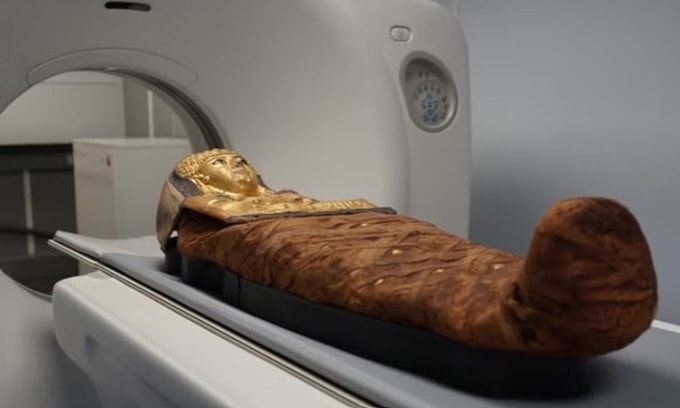Researchers discover how ancient Egyptians placed mummies of noblewomen in seemingly seamless coffins.

Chicago's Field Museum is home to more than a dozen ancient Egyptian mummies, but one in particular has puzzled researchers for years. Now, the mystery of how the mummy, Lady Chenet-aa, was buried appears to have been solved thanks to a CT scan.
Lady Chenet-aa lived 3,000 years ago during the 22nd Dynasty of Egypt's Third Intermediate Period. Shortly after her death, morticians prepared her for the afterlife by creating a cardboard box, a material similar to papier-mâché, to house her body. However, there are no visible seams in Chenet-aa's case, leaving Egyptologists wondering exactly how the embalmer placed her inside the box.
"The inner cartonnage appears to be one piece and smooth without any external seams (unlike the outer wooden coffin). If you look at the shape of the cartonnage, the opening at the foot is too narrow for the mummy's shoulders to fit through," said HP Brown, a conservation specialist at the Field Museum.
Computed tomography (CT) scans create 3D images of objects by digitally stacking thousands of X-ray scans. Over four days, researchers transported 26 mummies (including Chenet-aa) to a mobile machine parked outside the Field Museum. The resulting images helped them figure out how the undertaker placed Chenet-aa inside the seemingly one-piece case.
According to Brown, the ancients made an incision in the back of the cartonnage and softened the material with moisture to make it pliable. After standing the mummy upright, they tied it to a pole with thin rope. Brown believes they lowered the coffin over Chenet-aa's head before sealing the incision with twine. Once the cartonnage was solid, they poured plaster over it, Brown explained. The paint on the outer layer of cartonnage was decorated and polished while the mummy was still in an upright position. Once finished, Chenet-aa was ready for burial.
The CT scans provide new details about Chenet-aa’s health in her final days. The team believes she died in her late 30s or early 40s, although they have not been able to determine the cause of death. She was missing several teeth when she died, while the remaining teeth showed signs of wear. Experts believe the cause was a diet that included salt grains that were too coarse for tooth enamel.
Next year, researchers hope to continue examining thousands of CT scans to learn more about life in ancient Egypt.
HQ (according to VnExpress)